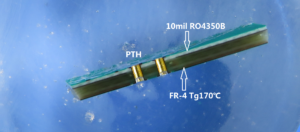Since the resolution capability of the traditional exposure machine is about 50μm, for the production of high level multilery printed circuit boards, a laser direct imaging machine (LDI) can be introduced to improve the image resolution capability, and the resolution capability can reach about 20μm.
The multilayer PCB board alignment controlling accuracy of traditional exposure machines is ±25μm, and the interlayer alignment accuracy is greater than 50μm. Using a high-precision alignment exposure machine, the graphic alignment accuracy can be increased to about 15μm, and the interlayer alignment accuracy is controlled within 30μm, which reduces the alignment deviation of traditional equipment and improves the interlayer alignment accuracy of high-rise pcb circuit boards.

Multilayer Circuit Board Inner Layer Circuitry Pattern Technology
In order to improve the line etching capability, it is necessary to make appropriate compensation for the width of the line and the pad (or solder ring) in the pcb circuit board reverse engineering design, and also need to make more detailed design for the compensation amount of special graphics, such as return lines, independent lines, etc.
Confirm whether the design compensation of inner layer line width, line spacing, isolation ring size, independent line, and hole-to-line distance is reasonable, otherwise, change the engineering design. There are impedance and inductance design requirements. Pay attention to whether the design compensation of independent lines and impedance lines is sufficient. Control the parameters during etching, and mass production can only be done after the first piece is confirmed to be qualified.
The traditional etching line equipment has insufficient etching capacity, and the equipment can be technically transformed or imported into high-precision etching line equipment to improve the etching uniformity and reduce the etching burrs, etching impurities and other problems.






